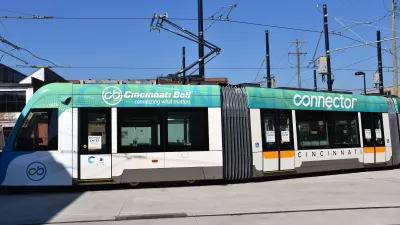The Southwest Ohio Regional Transit Authority (SORTA) has been busy negotiating with bidders regarding the potential operations of the forthcoming Cincinnati streetcar.
"Cost estimates for the two streetcar operating scenarios are in: One fits within the operating budget set by the city and the other does not, and there's a potential political fight brewing over which one will be selected," reports Chris Wetterich.
The two options, as described in documents obtained by the Cincinnati Business Courier:
- Management Option - "If the city decides that SORTA should employ most of the streetcar workers itself and have a third-party operator manage them, it will cost $4.7 million in the first year, according to documents obtained by the Business Courier. This 'management option' will cost $500,000 more than the top range of the city’s $3.8 million to $4.2 million operations budget."
- Turnkey Option - "If the city decides that SORTA should let the management company hire the streetcar staffers, the so-called 'turnkey option,' it will cost $4 million. The ATU is expected to unionize the private company’s employees if the city selects that option, but they will not receive state pension benefits."
The dueling proposals put Democratic representatives on the Cincinnati City Council in a bind, according to Wetterich, because the extra costs projected for the management option could lead to service cuts. It's a question of how much support they can offer unions and the pensions that come along with them, relative to the potential impacts of such a management scheme to the actual levels of service provided by the system.
FULL STORY: Here’s how much it will cost to operate Cincinnati's streetcar

Alabama: Trump Terminates Settlements for Black Communities Harmed By Raw Sewage
Trump deemed the landmark civil rights agreement “illegal DEI and environmental justice policy.”

Study: Maui’s Plan to Convert Vacation Rentals to Long-Term Housing Could Cause Nearly $1 Billion Economic Loss
The plan would reduce visitor accommodation by 25% resulting in 1,900 jobs lost.

Why Should We Subsidize Public Transportation?
Many public transit agencies face financial stress due to rising costs, declining fare revenue, and declining subsidies. Transit advocates must provide a strong business case for increasing public transit funding.

Wind Energy on the Rise Despite Federal Policy Reversal
The Trump administration is revoking federal support for renewable energy, but demand for new projects continues unabated.

Passengers Flock to Caltrain After Electrification
The new electric trains are running faster and more reliably, leading to strong ridership growth on the Bay Area rail system.

Texas Churches Rally Behind ‘Yes in God’s Back Yard’ Legislation
Religious leaders want the state to reduce zoning regulations to streamline leasing church-owned land to housing developers.
Urban Design for Planners 1: Software Tools
This six-course series explores essential urban design concepts using open source software and equips planners with the tools they need to participate fully in the urban design process.
Planning for Universal Design
Learn the tools for implementing Universal Design in planning regulations.
Caltrans
Smith Gee Studio
Institute for Housing and Urban Development Studies (IHS)
City of Grandview
Harvard GSD Executive Education
Toledo-Lucas County Plan Commissions
Salt Lake City
NYU Wagner Graduate School of Public Service



























